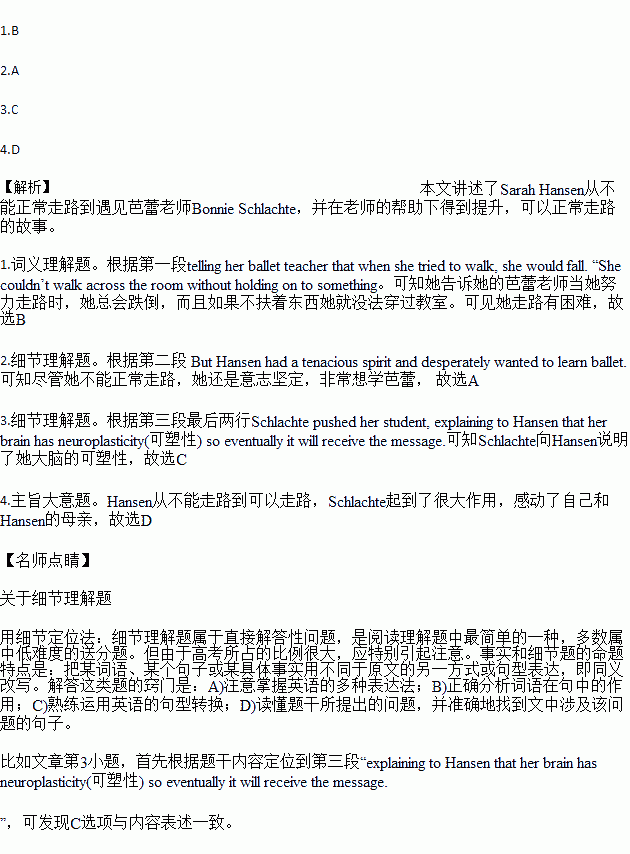题目内容
When Sarah Hansen first came to Bonnie Schlachte’s ballet studio, she jokingly called herself a “weeble-wobble,” telling her ballet teacher that when she tried to walk, she would fall. “She couldn’t walk across the room without holding on to something,” recalls Schlachte. “She would immediately fall.”
Hansen was only in middle-school, but a progressive neurological disease was hindering her ability to walk, let alone do ballet. But Hansen had a tenacious spirit and desperately wanted to learn ballet. Hansen joined in weekly group classes at Schlachte’s ballet studio called Ballet for all Kids, a studio that teaches children with disabilities. Soon after she began classes and private lessons, her family saw a vast improvement in her ability to move.
She worked tirelessly in the studio, focusing on what her instructor wanted from her. “At the time, her foot wouldn’t fully rest on the floor,” explains Schlachte. “That’s why she couldn’t stand on her own, there was no support.”
Schlachte pushed her student, explaining to Hansen that her brain has neuroplasticity(可塑性) so eventually it will receive the message.
As a mom, a classically trained ballerina, and holding a degree in psychology, Bonnie Schlachte was the perfect person to push Hansen to do her best. Schlachte put herself through college with dance and theater scholarships. After graduation, she came across an opportunity with children with developmental disabilities. She fell in love and chose to focus on jobs in that field.
Years later, Schlachte found herself watching and celebrating Hansen, who at one point could barely walk, was now moving across the floor on her own two feet. “One day, her ankle dropped, and she put her whole foot on the ground,” says Schlachte. “I was crying, her mom was crying, it was a great moment.”
1.Why did Sarah Hansen call herself a “weeble-wobble”?
A. She met Bonnie Schlachte for the first time.
B. She had great difficulty in walking properly.
C. She could walk very fast carrying something.
D. She would stop herself from falling quickly.
2.What kind of person was Sarah Hansen?
A. Determined and hard-working.
B. Energetic and confident.
C. Happy and generous.
D. Anxious and careful.
3.What did Schlachte do to help Hansen walk?
A. She put Hansen’s foot fully on the floor.
B. She pushed Hansen in a wheelchair.
C. She asked Hansen to control her brain.
D. She paid the fee for her.
4.What made Schlachte and Hansen’s mother cry?
A. Hansen’s degree in psychology.
B. Hansen’s dance and theater scholarships.
C. Hansen’s opportunity with children.
D. Hansen’s improvement in walking.
| 抑郁症的危害性 | 治疗建议 |
| (1)这种强烈不良情绪会危害人的身心健康和社会行为; (2)严重的患者不能正常工作和生活,经常感到焦虑、伤心、无望等,更可怕的是,有自杀念头. | (1)只要态度乐观,及时治疗,多与他人交流,抑郁症是可以治愈的常见疾病之一; (2)养成锻炼身体的好习惯,以增强体质. (3)… |
【写作要求】1.信息内容完整,句子结构准确,篇章结构连贯;.2.书写工整,卷面整洁,美观. 3.字数:120词左右.

